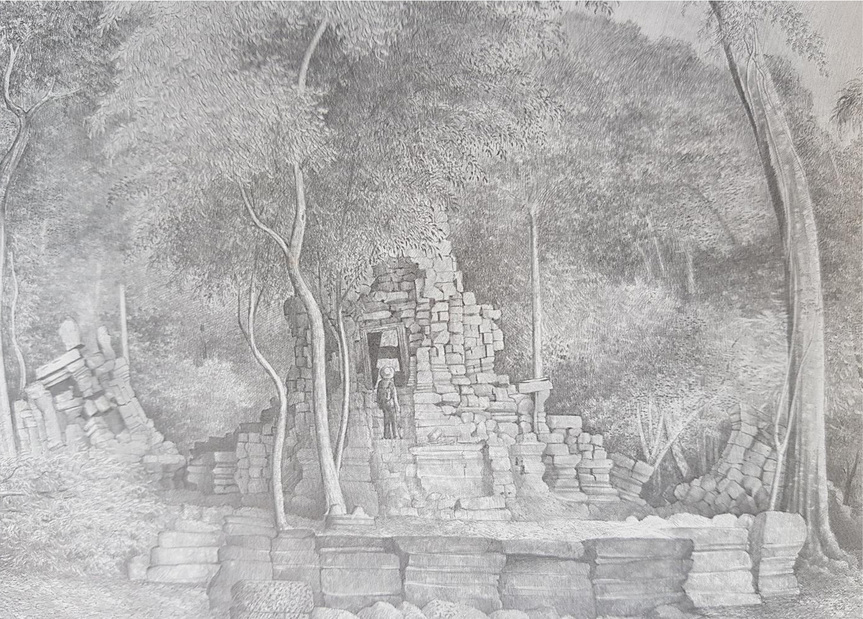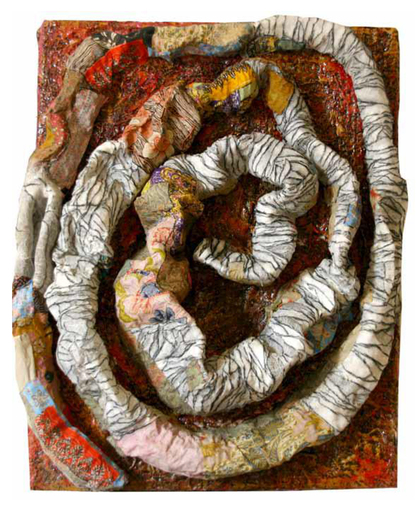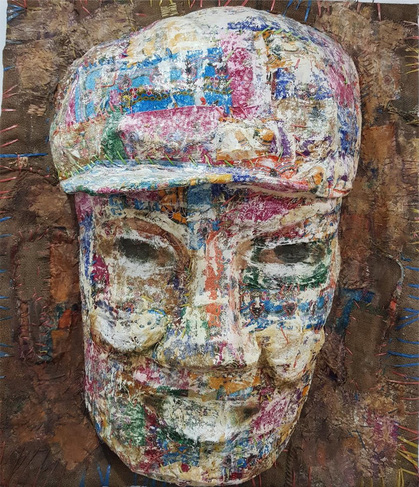
R
E
V N
E
X
T
Born in 1973 in Battambang, northwestern Cambodia, to a family of ten, Srey Bandaul spent most of his adolescence in the Site 2 Refugee Camp on the Thai-Cambodian border, for those displaced by the war between Vietnam and Khmer Rouge-controlled Cambodia. Despite the traumatic circumstances, the camp was where he first received basic art training in the form of a drawing class run by French humanitarian volunteer Véronique Decrop, unleashing his creative spirit and setting him on his path to an artistic career. Spanning sculpture, installation, performance, drawing and painting, Srey’s practice has gained international attention for its nuanced interweaving of autobiographical experiences with topics affecting modern-day Cambodia and beyond, such as healing and reconciliation, power relations, capitalism, and refugee crises.
Back in 1994, in Anh Chanh village, Srey and eight other colleagues founded Phare Ponleu Selpak, a multidisciplinary art center and one of the first contemporary art schools in Cambodia, where he still teaches. In the decades since, the surroundings have undergone a noticeable transformation, with apartment complexes springing up as rice fields are filled for development. Yet, just a stone’s throw from Phare, past a bricked gateway arched by yellow and purple floral vine, is a lush green patch of tropical plants and trees. The house on this site is Srey’s home-studio, which is cluttered with works in various stages of completion and other odds and ends. After a tour, Srey and I sat down in his garden to discuss the evolution of his practice.
You primarily used pencil and paper during the early part of your career. Why this medium, and what was your first project?
It’s straightforward. Our country back then [immediately after the war] had not many choices—there were no paints except watercolor, and even watercolor was hard to find. Sometimes there were no brushes. So I was convinced that pencil and paper is the easiest way.
My first solo show, “Looking at Angkor” (1998), was at Phare Ponleu Selpak, and then it traveled to the Reyum Institute of Arts and Culture in Phnom Penh. In 1995, I had visited Siem Reap, and I found myself at the temple prostrating before the ruins. The sense of nationalism was strong as I had learned a lot about Angkor Wat when I was in school. When I arrived at the temple and saw religious artifacts being copped off or decapitated, I was so saddened. That was my first project, “Looking at Angkor.” I drew the temple and the religious artifacts to express my feelings. The project was later picked up by Reyum and Professor Ashley Thompson [a specialist in Southeast Asian cultural histories], and published as a book [of the same name in 2006].
You began to work with paint and canvas in 2005. What triggered the change?
I went to Burma in 2000, France in 2003, and took part in a residency in Norway in 2004. This traveling opened up new possibilities for me. I started using paint and canvas and exploring abstract painting. Traveling allows one to see and explore new ideas, to learn and exchange. It is not only for artists, but for everyone, in all fields. It’s important because we can’t stay still in one place. But my use of paint and canvas is still in the process of experimentation and researching, though I’ve begun to explore the combination of abstraction and realism.
From drawing to painting, to sculpture and installation, and to performance, I’ve used many mediums. I don’t like to do the same thing, I like to explore and research. People have asked me why my works keep changing in style and technique. I think the answer is because I’m still searching for what I really love. I used to think what I made in the past [1994–2009] was contemporary art, but I don’t think that now. I think they were still in the moment of the classical and the modern. For me, the contemporary must have a unique technique and use of materials, and must respond to my life experience; my life experience can be transferred into the artwork. It should have symbols and those symbols must be powerful and draw people in.
I understand that more recently you discovered an interest in using the printed textile, sarong, for example in your performance-installation Digestion (2015) including sculptural, fabric intestines, and in your installation of sculpted human figures surrounded by charcoal, Under Sarong (2015).
For sculptural works, I found meaning in the use of sarong and mosquito nets. Sarong has a connection to my life and Cambodian culture in general. When I was young, sarong was my blanket; we had nothing else to cover ourselves. In the countryside, people still use sarong [for their everyday clothes]. And most importantly sarong has been used as a gift for political exchange; the fabric has been used by the ruling Cambodian People’s Party to buy voters’ hearts. For me, sarong also has a female energy; it represents women. The mosquito net is part of my childhood memory as well. I remember sharing a net with my family at night while we slept. The materials I use carry multiple meanings.
In 2006, I assigned my students a project to use sarong and krama [checked woven cloth] to create work in response to the theme of gender. But it was only in 2011 that I incorporated the material into my practice. I presented two sculptural installations made of coke cans, cardboard, sarong, sandals, and a pair of mannequins during the open studio [at the Lower Manhattan Cultural Council’s Arts Center] on Governors Island in New York, while completing my [Asian Cultural Council] residency.
What kinds of projects are you working on now?
I’ve been working on this project, “Beauty Is Only Skin Deep,” for almost a year now. My initial intention was to explore Khmer history, particularly the faces of those involved in instigating conflicts in Cambodia, from Khmer leaders to Chinese, Russian and American presidents. I wanted to make their portraits; not a full sculptural form, but like a bas-relief, where the faces are emerging from the canvas’s surface. However, while I patched and pasted the sarong and other materials to shape their likenesses, things changed, and that altered my intention too. At first, they bore some similarity to the faces, but after I left them for a while, the structures shrank and twisted, changing the facial forms. I had to redo them again, and then realized that I don’t need to make the faces look like anyone at all—they could be anyone.
In your studio, one piece in particular caught my eye—a sculpture of a reclining, fragmented Vishnu, the Hindu god. What struck me was its massive scale. Could you tell us more about this sculpture?
I replicate a fragment of an 11th century bronze sculpture at the National Museum of Cambodia, which, during its time, was venerated as an idol. When excavated, this sculpture was found incomplete, missing hands and half of its torso. I first reconstructed the piece in a small scale, but as I said earlier about the other works, the structure shrank and twisted. I had to redo it. Then I wanted to make it larger. This is my first time doing this kind of colossal work; it’s three times the size of the actual bronze sculpture. It has been a difficult task to deal with this piece. But it impresses me.
My Vishnu is a metaphor for the shifts in power over time, and for ideas on disability. Vishnu is worshipped as one of the supreme lords, the preserver of the cosmic order, who is supposedly charismatic and powerful. But the incompleteness desacralizes the sculpture. And by reconstructing the piece out of sarong, the statement is layered. I wish to make more large-scale works, and sculptures of powerful Khmer gods and devas.
Do you consider this a return to your past work incorporating imagery of temples and religious artifacts?
Yes, it is like a complete circle, but it is not moving backward. Moving backward would be when I repeat the same image and use the same technique, but this is different technique, a new form and new narrative. But it was not my intention to come full circle; it’s kind of a natural development.
You don’t seem too concerned about how an audience views your work. Is that true?
I don’t think I care about the audience. I just want to explore what I love, even though in these past few years my works have not sold. If I were interested in selling, I could just make work to fit the right market. But I do what I want and express what I think, and I still keep moving forward.
This interview has been edited for length and clarity.
To read more of ArtAsiaPacific’s articles, visit our Digital Library.




















